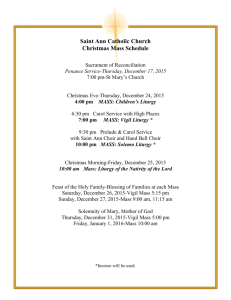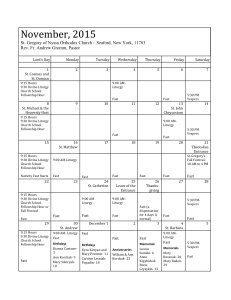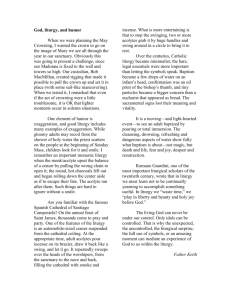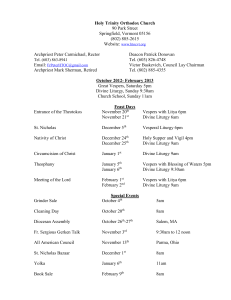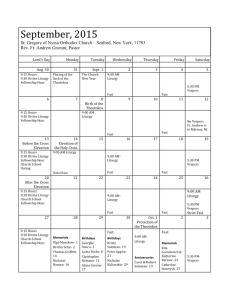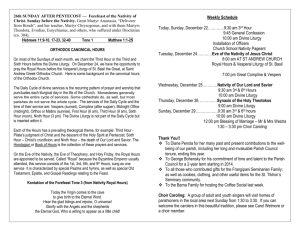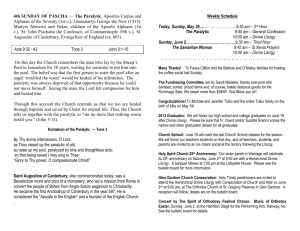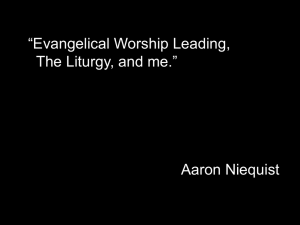THE DIVINE LITURGY - A PERSONAL REFLECTION
advertisement
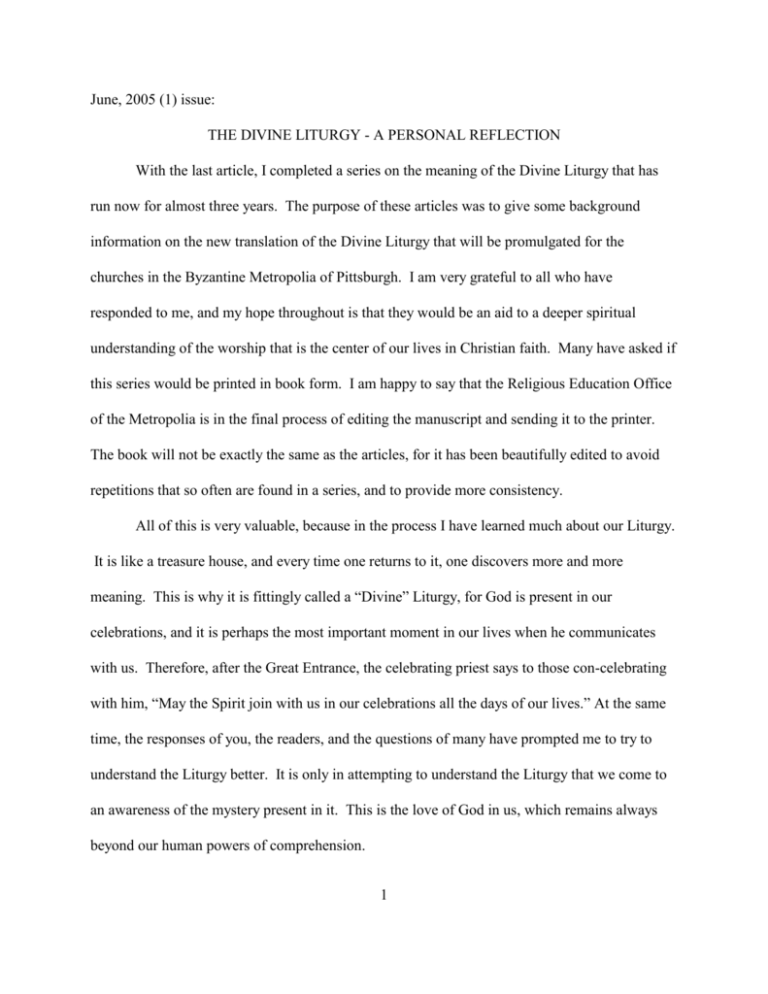
June, 2005 (1) issue: THE DIVINE LITURGY - A PERSONAL REFLECTION With the last article, I completed a series on the meaning of the Divine Liturgy that has run now for almost three years. The purpose of these articles was to give some background information on the new translation of the Divine Liturgy that will be promulgated for the churches in the Byzantine Metropolia of Pittsburgh. I am very grateful to all who have responded to me, and my hope throughout is that they would be an aid to a deeper spiritual understanding of the worship that is the center of our lives in Christian faith. Many have asked if this series would be printed in book form. I am happy to say that the Religious Education Office of the Metropolia is in the final process of editing the manuscript and sending it to the printer. The book will not be exactly the same as the articles, for it has been beautifully edited to avoid repetitions that so often are found in a series, and to provide more consistency. All of this is very valuable, because in the process I have learned much about our Liturgy. It is like a treasure house, and every time one returns to it, one discovers more and more meaning. This is why it is fittingly called a “Divine” Liturgy, for God is present in our celebrations, and it is perhaps the most important moment in our lives when he communicates with us. Therefore, after the Great Entrance, the celebrating priest says to those con-celebrating with him, “May the Spirit join with us in our celebrations all the days of our lives.” At the same time, the responses of you, the readers, and the questions of many have prompted me to try to understand the Liturgy better. It is only in attempting to understand the Liturgy that we come to an awareness of the mystery present in it. This is the love of God in us, which remains always beyond our human powers of comprehension. 1 Perhaps the most frequent question asked is, “why a new translation of the Liturgy?” Since our faith touches the very center of our being, changes in the practice of our faith are the most difficult to absorb. Human beings are always very conservative about their religion and about how they relate to God. The only answer can be that it was to try to increase the quality of that relationship. The project itself was authorized by the late Metropolitan Judson. He wanted to respond to the Church that was calling us to be faithful to our Eastern tradition. To do this, and to provide a Liturgy that would be the standard for all of our churches, it was necessary to make corrections to the 1964 translation. It was then felt that we should do the project right, not just cobble in a few corrections, but to do a translation that was clear and accurate and would serve the needs of our parishes. Work on this translation lasted from 1995 to 1999, and was finally reviewed by Rome and approved on March 31, 2001. It is now finally ready for promulgation by the Council of Hierarchs of the Pittsburgh Metropolia. Explanations of the Liturgy are now being given to the clergy, and catechetical material on both the text and the music will soon be available for the people. What needs to be said is that this is all a part of the process that began with the profound decision of our Church, beginning in the late 40's and early 50's to put the Divine Liturgy into the vernacular language so that it could be understood by the people. Though the Orthodox had made earlier translations, this idea was almost invisible in the Catholic Church of that age. It is, I think, one of the best decisions our Church has ever made. The Liturgy project is also, as just mentioned, a response to the call of the Church for us to be faithful to our Eastern heritage. For many years, the Roman Church, particularly through the Popes, has emphasized that this faithfulness is crucial to the health of the whole Church. The Church, in fact, cannot be “whole” unless it is enlivened by the tradition of the East. Since 2 communion does not yet exist between the Catholic and Orthodox Churches, this puts the burden on us, a small minority of both East and West, to represent the Eastern tradition within the Roman Church. At one time, the Roman Church saw us as a possible bridge to unity with the Orthodox, but now we are perceived as more of an obstacle. It has become evident that the Orthodox will not be tempted to reunion through the existence of the Eastern Catholic Churches. This has been discouraging to some, and the question might be raised: what, then, is the importance of our faithfulness to our Eastern tradition? This question does not have a simple answer. I have become convinced that it cannot even be formulated in words. Some have said that Eastern theology is more profound, that it emphasizes the importance of the mystery of the Trinity and of the deification of human beings. Both of these, and much more, is true, but words alone cannot be a sufficient motivation for the action that is necessary. The tradition of the East is a reality that is understood only when we live it out in its fullness. Tradition, of course, is more than mere customs and ways of acting, but the appropriation in our life of faith of the reality of God working in us for our salvation and for the welfare of the whole Church. We can understand what it means to be an Eastern Christian only by doing it - by living the faith to which we have been called. It is obvious from this that our Liturgy is not important to us for extraneous reasons - not for politics or for a sense of identity or even for the sake of unity - but only for the effects it has on us, both as individuals and as a community. We must be faithful to our heritage because this is the way we find God. 3
